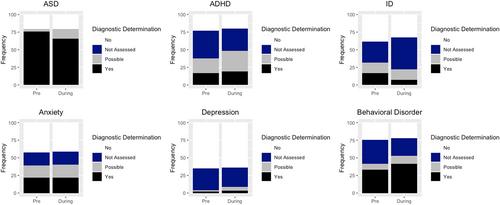Diagnostic certainty during in-person and telehealth autism evaluations
Abstract
Background
Many diagnostic evaluations abruptly shifted to telehealth during the COVID-19 pandemic; however, little is known about the impact on diagnosis patterns for children evaluated for autism spectrum disorder (ASD). The purpose of this clinical research study was to examine (1) the frequency of diagnoses evaluated beyond ASD; (2) the frequency of diagnoses made, including ASD; and (3) clinician diagnostic certainty for all diagnoses evaluated for children who received an evaluation due to primary concerns about ASD via telehealth during the pandemic compared to those evaluated in person before the pandemic at an ASD specialty clinic.
Methods
The sample included 2192 children, 1–17 years (M = 6.5 years; SD = 3.9), evaluated by a physician/psychologist at an ASD specialty center. A total of 649 children were evaluated in-person September 1, 2019–March 13, 2020 (pre-pandemic) and 1543 were evaluated via telehealth March 14, 2020–July 26, 2021 (during pandemic). Upon completion of each evaluation, clinicians provided a final diagnostic determination (i.e., “Yes,” “No,” “Possible,” or “Not Assessed”) for the following DSM-5 conditions: ASD, attention-deficit/hyperactivity disorder (ADHD), intellectual developmental disorder (IDD), anxiety (ANX), depression (DEP), and behavioral disorder (BD). “Possible” indicated lower certainty and the diagnosis was not provided. “Not Assessed” indicated the disorder was not evaluated.
Results
Diagnostic certainty for ASD and ADHD was lower and clinicians evaluated for and made diagnoses of IDD less often during evaluations that occurred via telehealth during the pandemic versus in person before the pandemic. DEP and BD were diagnosed more frequently, diagnostic certainty of DEP was lower, and no differences in the frequency of ANX diagnoses emerged during evaluations conducted via telehealth during the pandemic compared to those conducted in person before the pandemic.
Conclusions
Differences emerged in the frequency of diagnoses evaluated and made and diagnostic certainty for evaluations conducted via telehealth during the pandemic compared to in person before the pandemic, which likely impacted patients and reflect real-word challenges. Future work should examine whether these patterns are generalizable and the mechanisms that contribute to these differences.


 求助内容:
求助内容: 应助结果提醒方式:
应助结果提醒方式:


